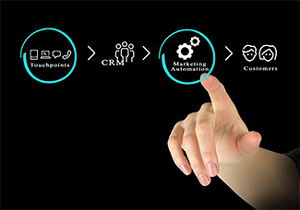 Nearly every industry follows a similar sales cycle. Potential customers develop a need for or become aware of a product, research that product, consider their options, make a purchase decision, and then potentially make subsequent purchases in the future. In simple terms, these steps can be referred to as awareness, research, consideration, purchase, and retention. While nuances may exist from one industry to another, the basic steps remain the same.
Nearly every industry follows a similar sales cycle. Potential customers develop a need for or become aware of a product, research that product, consider their options, make a purchase decision, and then potentially make subsequent purchases in the future. In simple terms, these steps can be referred to as awareness, research, consideration, purchase, and retention. While nuances may exist from one industry to another, the basic steps remain the same.
[quotesright]By the time a prospect contacts you, they have already learned enough to think they know the options and have mostly made up their minds about what they need. [/quotesright] The problem is that much of what they know “just ain’t so.”
The sales cycle steps themselves will likely always exist in one form or another, but the mechanism of their execution has undergone dramatic changes over the past 15 to 20 years. As more and more of the steps have moved online, the traditional roles of sales and marketing need to adapt to dealing with better informed customers who think they know the solution; today it’s often just a question of who is OK and cheapest.
That poses a big problem for sales and marketing today. How they diagnose their problem is often faulty and therefore [quotes]their solution is likely to be the perfect solution to the wrong problem and that can cost you the sale.[/quotes] Just ask your doctor about patients requesting specific prescriptions that are heavily advertised for their self-diagnosed illnesses…
How did we get here?
Formerly, prospects had three ways to get information about a specific product beyond what was contained in a typical advertisement:
- Attend a tradeshow,
- Contact a salesperson, or
- Visit a company location.
Those three options remain valid avenues for researching a product or service; however, they have one trait in common: [quotesright]all three require the prospect to identify themselves in exchange for information. Over the past 20 years, companies have made most of that same information available over the Internet. [/quotesright]
At first glance, it sounds great that all of the information about your company and products is now instantly at your prospects' fingertips. However, the Internet is a relatively anonymous place, so you may no longer be able to identify prospects early in the sales cycle. In most cases, they can now obtain all of the information they believe they need completely anonymously online.
[quotes]By the time you identify prospects, they are likely already very close to a purchase decision. [/quotes] In fact, you may only learn their identity because they are in the process of completing a purchase. You may never know who they are if they don't purchase from you. This shift has happened gradually, and you may not have even noticed its occurrence.
[sidebarright225]
Changing the questions begins with how you think about your customer
 Dealing with the new reality of how your prospects think and turning those insights into changes in your marketing and sales process starts with understanding how sales and marketing has changed so dramatically and be one of the leaders who gets ahead of the curve and thinks differently from others in your industry.
Dealing with the new reality of how your prospects think and turning those insights into changes in your marketing and sales process starts with understanding how sales and marketing has changed so dramatically and be one of the leaders who gets ahead of the curve and thinks differently from others in your industry.
Change is hard and nearly impossible on your own. That’s where we come in, helping you look at your market and business in new ways so you are focusing your time and effort on the best ways to capture the changes in the way clients buy today.
Let’s talk, there is never any obligation. USA: 877.433.6225 feedback@focalpointcoaching.com
[/sidebarright225]
How can you optimize your business to compete in this new sales cycle?
- Interview your top salespeople to understand their best practices. Many sales professionals don't use the materials and tools created by the marketing department. They often prefer ones they have developed on their own that you may not know about. Integrate their best practices into your content.
Since your website is now completing some of the early sales cycle tasks formerly completed by your sales team, you will want to make sure it is completing them as accurately as possible. While no substitute for the human touch currently exists, it is important to try and make the user experience as genuine as possible.
- Understand how your customers think about their business and what makes it tick then use your web presence to influence prospects early in the sales cycle. Since online research is now a significant component of most prospects' evaluation, your web presence should [quotesright]include a strong educational component that makes them question if they are asking the right questions[/quotesright] so they see your product differently than your competition’s product.
Direct them to relevant landing pages containing the right information for that particular point in the sales cycle. Product guides that disrupt how they are thinking about their problem while highlighting the true nature of the problems they have presents a unique opportunity to discuss your company's products and how they uniquely solve those problems.
As prospects research a type of product, what better source for them to get their information than your company?
- Become more adept at identifying prospects online. Just like in tradeshow settings, many truly interested prospects will identify themselves in exchange for a valuable piece of information they cannot obtain elsewhere.
[quotesright]Consider what information or materials you would not want to hand over to prospects without receiving some basic information about them in return. [/quotesright]
Offers or subscriptions to e-newsletters can be used to barter for identity as well. Only request the information you truly need. The more information you require, the fewer the prospects willing to identify themselves for it.
- Integrate your online presence and your sales team seamlessly. As prospects move through the sales cycle from research to consideration, your web presence must pass them off to the sales team at the appropriate moment for a personal touch. Your sales team should be able to pass prospects back to the web for additional information or further nurturing when needed. Your online presence should complement your sales team, not replace them.
- Embrace new sales and marketing tools available for your business. Customer Relationship Management or "CRM" software platforms can manage and organize all of your customer interactions into a single database.
Many CRM platforms can be integrated into a marketing automation software platform, allowing you to streamline many of your customer communications, such as emails, webinars, and advertisements. Investigate the tools available to assist your business and utilize the ones best for you.
The ability of your CRM to handle marketing automation is vital as adding automation helps move your customer through the sales process by automating much of the interaction they have with your company. That helps them get relevant information sooner, keeps a dialogue open with prospects and moves them along with a combination of automated steps and handoffs to sales or marketing team members as needed. A good sales automation system will let your team pass them on to a sales representative or back into the automated process.
When done well, CRM and Marketing Automation can dramatically improve your close rate.
- Study your data. Companies are now able to capture more data than ever before. This data can tell you many things about your prospects and customers, such as what actions indicate a purchase is eminent, what communications nurture a prospect into a customer and how they make a purchase decision. Analyze this data and use it to formulate sound plans as you develop your overarching strategy.
Sales cycle changes have affected nearly every industry. [quotes]While many of the nuances can vary from business to business, the overall theme remains the same: the majority of the sales cycle is now occurring anonymously online. [/quotes] Ensuring that your web presence assists your sales team in moving prospects toward a sale is essential in today's business climate.
[quotesright]Think smarter about your business and the dialogue you are having with your customers. [/quotesright]Early on, if you guide their diagnosis of their problems in a way that highlights your superiority, you’ll stand apart from your competition. By implementing the web, CRM, and sales automation tools available to you, your company will be set up for success.














